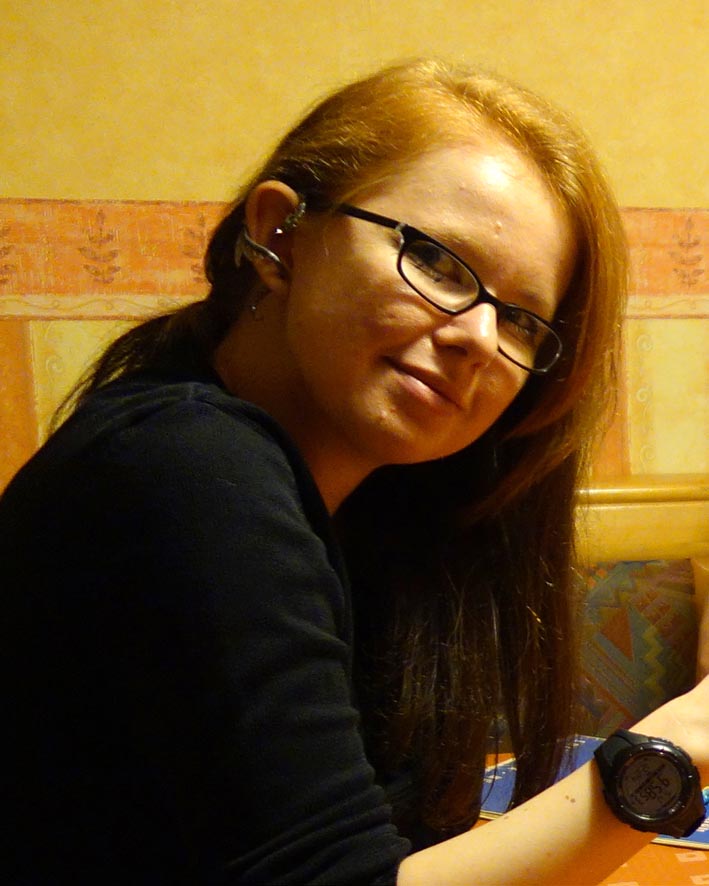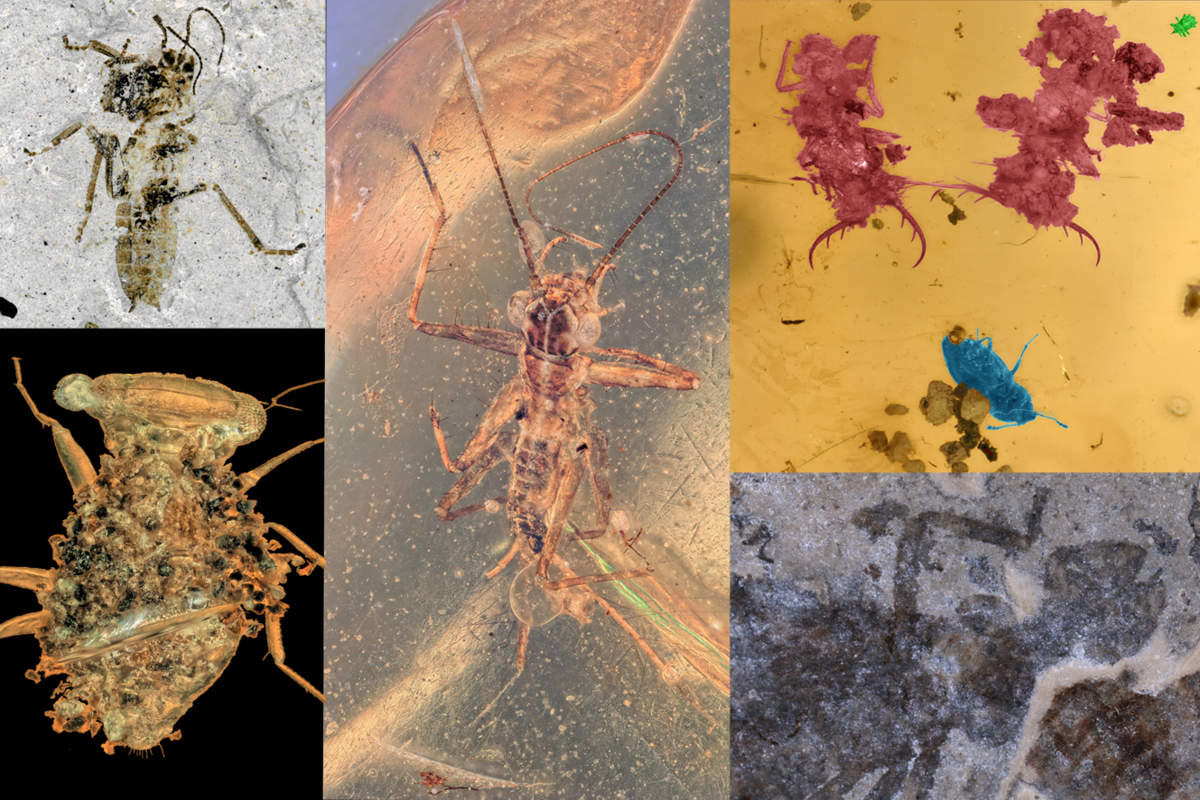
Christine Kiesmüller, M.Sc.
Zoological Institute and Museum
Cytology and Evolutionary Biology
Soldmannstr. 23
House 6.1
17489 Greifswald
Phone: +49 (0)3834 420 4065
Fax: +49 (0)3834 420 4067

My research interest lies predominantly in the development and evolution of arthropods. During my Bachelor Thesis I worked on fossil insects (Palaeodictyoptera) and cockroaches (Dictyoptera) and the development of their wings (cf. Kiesmüller et al. 2019). I also worked on a few research practical during my Master studies comprising different research areas: camel spiders (Solifugae) and their tagmatisation, cockroaches and a potential wing locking-mechanism and also on peculiar marine slugs (Heterobranchia, Mollusca) which had a probably secondarily coiled visceral sac similar to that found in terrestrial snails (but without the shell). My Master Thesis was on the pupal development of flour beetles (Tenebrionidae, Coleoptera, Insecta) during which I tried different techniques to look inside the pupae (histology and cuticle made transparent).
<¤¤¤♦♦♦¤¤¤>
Now I’m mostly interested in adaptions for a predatory or predator-avoiding (prey) life style in insects. In my PhD thesis I will work on this with the title: “To eat or to be eaten” in the fossil record – functional adaptations of predatory insects and their prey.
Insects like most animals can be categorised as either predator or prey (or both), so adaptations to a predatory or predator-avoiding life style are very common. That’s also why predator-prey-interactions are a general principle of ecology: even Darwin studied these types of interactions. Adaptations of this kind can take hold on different layers of interactions, meaning that adaptations can be looked at either from the perspective of the predator or the prey (and sometimes both at the same time). So adaptations for a predatory life style could mean for instance repurposing of appendages for prey capture, this is e.g. found in assassin bugs which have raptorial forelegs similar to those found in mantodeans.
These days most ecologists who work on predator-prey interactions work with models of these systems and less with field work, probably because these interactions are more difficult to assess in the field, especially in smaller animals such as insects. This is why morphology and also predominately functional morphology is more and more important. Due to the behavioural aspect of these interactions, it is difficult to observe in the field and even more so in the fossil record. Nonetheless the work with fossils can show results, because behaviour doesn’t have to be directly observed (‘frozen behaviour’), but it can be indirectly inferred as well. There are many different methods regarding this, all of which have some connection to the preservation of the fossils.
An example of a well preserved fossil is e.g. odonatan (dragonfly) larvae with its characteristic raptorial labial mask (cf. image above, right lower corner). Odonatan larvae are fierce ambush predators in the aquatic realm and can also be found in the fossil record. But even if the preservation doesn’t allow detailed observation of the animal or if only parts of the animal are preserved, you still can use a phylogenetic position to pinpoint potential behaviour exhibited by them when comparing to the behavioural range of closely related recent species of this group.
| Landesgraduiertenförderung (Ph. D. scholarship of national (Mecklenburg-Western Pomerania) funding) (39,600€) |
| Congress student support scholarship for the ICIM5 (5th International Congress on Invertebrate Morphology) (400€) |
| Deutsche Zoologische Gesellschaft e.V. (DZG) (German Zoological Society) |
| International Society for Invertebrate Morphology (ISIM) |
| Paläontologische Gesellschaft (PalGes) (Palaeontological Society, Germany) |
- Kiesmüller C, Haug GT, Hörnig MK, Haug JT: “New findings of nymphs of the orthopteran group †Elcanidae in 100 million-year-old amber: a functional-morphological discussion about the potential function of their metatibial spurs“. 93rd Annual Meeting of the Paläontologischen Gesellschaft (PalGes) Stuttgart 2022.
- Kiesmüller C, Haug JT, Hörnig MK: ““Camouflage” in immature bark lice in 100 million-year-old amber“. 92nd Annual Meeting of the Paläontologischen Gesellschaft (PalGes) Vienna (online) 2021.
- Kiesmüller C, Hörnig MK, Haug JT: “Segmental mismatch in a nymphal cockroach: a case of left-right asymmetry”. Entomology Congress of the German Society for General and Applied Entomology (DGaaE) Freising 2017.
- Kiesmüller C, Haug C, Hörnig MK, Haug JT: "Long-legged aphidlion-like larva: new findings in 100-million-year old amber illuminate life style and ecology of strange-looking neuropteran larvae". 5th Young Researcher Meeting Morphology (YRMM24; Graduate Forum of the DZG) Darmstadt 2024.
- Kiesmüller C, Haug JT, Hörnig MK: "Ecology in deep time: how morphology can elucidate predatory and predator-avoiding specialisations of extinct insects". 2nd Asian Palaeontological Congress (APC2) Tokyo 2023.
- Kiesmüller C, Haug JT, Hörnig MK: "“Fressen und gefressen werden”: morphologische Spezialisierungen von Räuber-Beute-Interaktionen im Fossilbefund der Insekten". Workshop AG Palaeobiology, 93rd Annual Meeting of the Paläontologische Gesellschaft (PalGes) Stuttgart 2022.
- Kiesmüller C, Haug GT, Hörnig MK, Haug JT: "New findings of nymphs of the orthopteran group †Elcanidae in 100 million-year-old amber: a functional-morphological discussion about the potential function of their metatibial spurs". 93rd Annual Meeting of the Paläontologische Gesellschaft (PalGes) Stuttgart 2022.
- Kiesmüller C, Haug JT, Hörnig MK: "“To Eat or To Be Eaten”: morphological specialisations of predator-prey interactions in the fossil record of insects". 114th Annual meeting of the German Zoological Society (DZG) Bonn 2022.
- Kiesmüller C, Haug JT, Hörnig MK, Stahlecker C, Haug C, Hörnig MK, Haug JT: "The raptorial appendages of adult praying mantises and predatory lacewings 100 million years ago and today". 5th International Congress on Invertebrate Morphology (ICIM5) Vienna 2022.
- Kiesmüller C, Haug JT, Hörnig MK: ““Camouflage” in immature bark lice in 100 million-year-old amber“. 92nd Annual Meeting of the Paläontologische Gesellschaft (PalGes) Vienna (online) 2021.
- Kiesmüller C, Haug JT, Hörnig MK: “A case of frozen behaviour: A putative parasitoid flat wasp with a beetle larvae in its grasp in 100 million years old amber”. 113th Annual meeting of the German Zoological Society (DZG) Würzburg (online) 2021.
- Kiesmüller C, Haug JT: “A look inside: Approaching the “mysterious” pupal development of holometabolan insects“. 111th Annual meeting of the German Zoological Society (DZG) Greifswald 2018.
- Kiesmüller C: “Entwicklung bei Palaeodictyoptera: Neue Nymphenfunde vom Piesberg mit massivem Ovipositor”. Conference of German Palaeoentomologists (Paläoentomologen-treffen) Bonn 2015.
- Kiesmüller C: “The raptorial appendages of adult praying mantises and predatory lacewings, 100 million years ago and today”. Evaluation Volkwagen Professorship Dr. JT Haug, Munich 2022.
- Kiesmüller C, Wilson NG, Jörger KM, Neusser TP: “Another weird secondarily coiled acochlidian slug—3D-reconstruction of Helicohedyle sp. from Lord Howe Island”. 6th International Heterobranch Workshop (IHW) Fremantle 2018.
- Kiesmüller C, Haug C: “Tagmatisation in camel spiders: how functional constraints shape a complex body organisation”. 4th International Congress on Invertebrate Morphology (ICIM4) Moscow 2017.
- Kiesmüller C, Hörnig MK, Haug JT: “Segmental mismatch in a nymphal cockroach: a case of left-right asymmetry”. Entomology Congress of the German Society for General and Applied Entomology (DGaaE) Freising 2017.
- Bjarsch J*, Kiesmüller C*, Kolb T*, Biging A, Brück L, Chretien J, Gauweiler J, Kammerer D, Klaffke K, Kraemer P, Nagler C, Wagner P, Richter A-C, Hörnig MK, Haug C, Haug JT: “Studentische Exkursion mal anders—ab in die Sammlung”. 18th Conference of German Crustaceologists (Crustaceologentagung) Berlin 2017. *first three authors were presenting (in alphabetical order)
- Kiesmüller C, Haug C: “Tagmatisation in camel spiders with a focus on the special condition of the anterior body”. 109th Annual meeting of the German Zoological Society (DZG) Kiel 2016.
- Kiesmüller C, Hörnig MK, Leipner A, Haug C, Haug JT: “Evolution of the ontogenetic development of wings: data from supposedly ‘primitive’ flying insects”. 108th Annual meeting of the German Zoological Society (DZG) Graz 2015.
Publications
2023
- Haug C, Haug JT, Haug GT, Müller P, Zippel A, Kiesmüller C, Gauweiler J, Hörnig MK (2023***). Fossils from the Myanmar amber forest demonstrate the diversity of anti-predator strategies of holometabolan insect larvae about 100 million years ago. iScience 27(1): 10862. Open Access; ***published online 2023, issue 2024
- Haug C, Haug GT, Kiesmüller C, Haug JT (2023). Convergent evolution and convergent loss in the grasping structures of immature earwigs and aphidlion-like larvae as demonstrated by about 100-million-year-old fossils. Swiss Journal of Palaeontology 142(1): 21. Open Access
- Haug C, Pérez-de la Fuente R, Baranov V, Haug GT, Kiesmüller C, Zippel A, Hörnig MK, Haug JT (2023). The first fossil record of a mantis lacewing pupa, and a review of pupae in mantispidae and their evolutionary significance. Rivista Italiana di Paleontologia e Stratigrafia 129(1): 185–205. Open Access
2022
- Kiesmüller C, Haug J, Müller P, Hörnig MK (2022). A case of frozen behaviour: A flat wasp female with a beetle larva in its grasp in 100-million-year-old amber. Fossil Record 25(2): 287–305. Open Access
- Baranov V, Pérez-de la Fuente R, Engel MS, Hammel J, Kiesmüller C, Hörnig MK, Pazinato PG, Stahlecker C, Haug C, Haug JT (2022). The first adult mantis lacewing from Baltic amber, with an evaluation of the post-Cretaceous loss of morphological diversity of raptorial appendages in Mantispidae. Fossil Record 25(1): 11–24. Open Access
- Haug JT, Hörnig MK, Kiesmüller C, Pazinato PG, Baranov V, Haug C (2022). A 100-million-year-old cricket with unusual mouth parts and the convergent evolution of raptorial appendages within Polyneoptera. Geodiversitas 44(4): 57–73. Open Access
- Haug JT, Kiesmüller C,Haug G, Haug C, Hörnig MK (2022). A fossil aphidlion preserved together with its prey in 40 million-year-old Baltic amber. Palaeobiodiversity and Palaeoenvironments 103(1): 155–163. Open Access
2021
- Kiesmüller C, Haug JT, Müller P, Hörnig MK (2022**). Debris-carrying behaviour of bark lice immatures preserved in 100 million years old amber. PalZ 96(2): 231–258. Open Access; **published online 2021, printed 2022
- Zippel A*, Kiesmüller C*, Haug GT, Müller P, Weiterschan T, Haug C, Hörnig MK, Haug JT (2021). “Long-headed predators in Cretaceous amber—fossil findings of an unusual type of lacewing larva.” Palaeoentomology 004(5): 475–498. Open Access; *shared first authorship
2020
- Hörnig MK, Kiesmüller C, Müller P, Haug C, Haug JT (2020). A new glimpse on trophic interactions of 100-million-year old lacewings. Acta Palaeontologica Polonica 65(4): 777–786. Open Access
2019
- Kiesmüller C, Hörnig MK, Leipner A, Haug C, Haug JT (2019). Palaeozoic palaeodictyopteran insect nymphs with prominent ovipositors from a new locality. Bulletin of Geosciences 94(1): 23–40. Open Access
